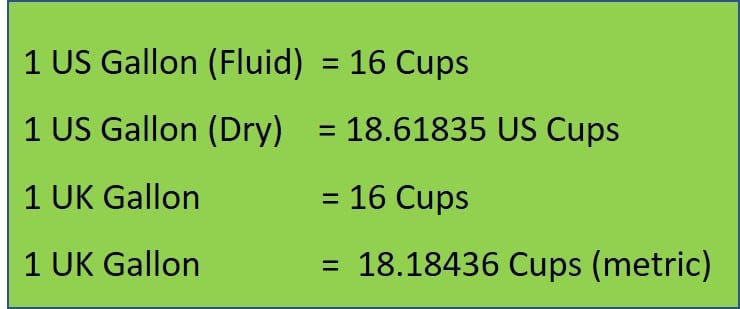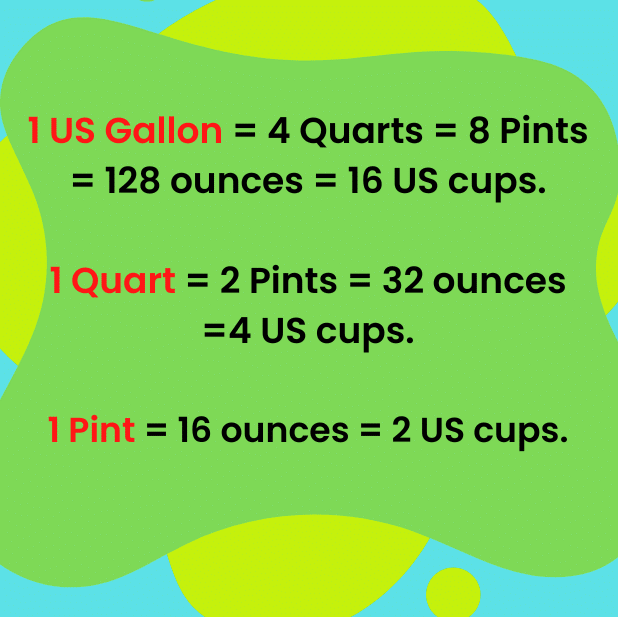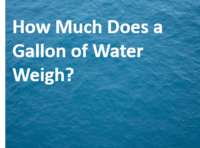A US liquid gallon is equivalent to 16 cups, whereas a US dry gallon is equivalent to 18.61 cups.
One cup is half a pint in the United States (236.6 ml).
1 US gallon = 16 cups
1 US gallon = 3.78 liters
One Imperial gallon is equal to 1.2 US gallons.

Table of Contents
How Many US Cups in a Gallon?
| 1 US gallon of water | 16 cups |
| ½ US gallon of water | 8 cups |
| US Cups to Pints | 2 cups = 1 pint |
| US Ounces to Cups | 8 fluid ounces = 1 cup |
| Cups in a Quart | 1 Quart = 4 cups |
What Is A Gallon?
In 1824, the British adopted the Imperial measure, in which a fluid gallon is equal to 10 pounds or 277.42 cubic inches of water. The United States had adopted a system where a gallon was comprised of 231 cubic inches of water.
What Is A US Gallon?
The legal definition of a U.S. liquid gallon is 231 cubic inches, which is equal to (exactly) 3.785411784 liters (1 L = 10-3 m3) or 0.13368 cubic feet. In the United States, this is the most frequent definition of a gallon. The fluid ounce in the United States is equal to 1/128 of a gallon in the United States.

What Is An Imperial Gallon?
The legal definition of an imperial (UK) gallon is 4.54609 liters (277.42 cu in), which is around 1.2 US liquid gallons. This standard is based on the volume of 10 pounds of water at 62 degrees Fahrenheit and is used in Commonwealth countries and Ireland. (A gallon of water in the United States weighs around 8.33 pounds at the same temperature.)
Weight Of Water
The weight of water depends upon the temperature at which it is stored.
1 US gal of water = 8.345 pounds, which is 3.785 kg (at 17 °C).
1 imperial gal of water = 10.02 pounds, or 4.545 kg (at 17 °C).
The weight of 1 liter (l) of pure water (at 4 °C) is equal to 1 kilogram (kg).
Density Of Water
At 4.0 °C (39.2°F), the density of water in g/ml is 0.9998395. This is the same as 1 gram per milliliter (g/ml) or 1 gram per cubic centimeter (g/cm3), rounded up.
The grams per milliliter (1 g/ml), grams per cubic centimeter ( g/cm3), and pounds per cubic foot ( lb/ft3) are common water quantities. At 4°C, the density of fresh water on Earth is typically assumed to be 1000 kg/m3.
Density is the amount of matter in a certain volume. It is the mass-to-volume ratio of a substance. If we use the same amount of wood and iron, we’ll discover that iron is significantly heavier than wood. This is because iron has a greater density than wood.
How Many Bottles Of Water Equal A Gallon?
A gallon (gal) is 231 cubic inches, which is equal to 3.785 liters or 7.58 bottles of water in the United States. One gallon is equal to 4.55 liters and 9.1 bottles in the Imperial system used in the United Kingdom. A gallon contains 128 fluid ounces, while a half-gallon has 64 fluid ounces.
Please refer to the full article “How many bottles of water equal a gallon?” for an in-depth analysis.
Difference Between the Metric System and the Imperial System
The Imperial System of Measurement and the Metric System of Measurement are the two basic systems for measuring distances and weight. The Metric System, which uses measurement units such as meters and grams and adds prefixes such as kilo, milli, and centi to count orders of magnitude, is used by the majority of countries. People in the United States employ the older Imperial system, which measures things in feet, inches, and pounds.
Some commonly used measuring units are listed below:
A mile is equivalent to 1.6 kilometers.
1 inch is approximately 25 millimeters or 2.54 cm.
A 3-foot measurement is nearly one meter.
1 kilogram is little more than 2 pounds.
1 pound is about 454 grams
Summary
- The answer to the question, “How many cups are in a gallon?“: 1 US gallon equals 16 cups, 1 US gallon equals 3.78 liters, and 1 Imperial gallon equals 1.2 times the US gallon.
- One liquid gallon in the United States equals 231 cubic inches, which is equal to 3.785411784 liters, which is equal to 0.13368 cubic feet.
Related Links
Chemical Formula for Water
Is Water a Mixture?
Soft Water vs. Hard Water
The Specific Gravity of Water
How Much is a Liter of Water?
What is Fresh Water?
Frequently Asked Questions
1. Why does oil float on water?
Oil floats on water because its density is lower than that of water. Density in liquids is defined as the amount of mass that may be filled into a cubic meter of volume. Water has a density of roughly 1000 kg/cubic meter, while oil has a density ranging from 800 to 960 kg/cubic meter.
2. Is water a mixture?
Water is not a mixture. It is a pure hydrogen-oxygen compound. Simply put, hydrogen and oxygen react chemically to form a compound called water.
3. What is portable water?
Water fit for human consumption is defined as potable water (i.e., water that can be used for drinking or cooking). The term implies that the water is both safe and drinkable.
Non-potable water is water that is unfit for drinking but, depending on its quality, can be used for a variety of other purposes.
3. What is the specific gravity of water?
The specific gravity of water is 1 at 4 degrees Celsius because this is the standard value used by scientists to determine the specific gravity of various substances. However, A water sample was taken at a different temperature or pressure, or one that contains impurities has a slightly different specific gravity value.
Conclusion
Cups to the gallon is a common conversation in our daily lives because both quantities are utilized frequently. To comfort you, 1 gallon equals 16 cups in the United States.
More Links
The pH of Distilled/ De-Ionized Water
Why is Water a Polar Molecule?
Specific Heat of Water
is water a pure substance?
Surface Tension of Water
Cubic Foot of Water Weight
What is Quarts Unit?
Weight of Water| Properties of Water
- BCl3 Lewis Structure in four simple steps - November 1, 2023
- PH3 Lewis Structure in four simple steps - October 8, 2023
- PF3 Lewis structure in four simple steps - September 24, 2023



